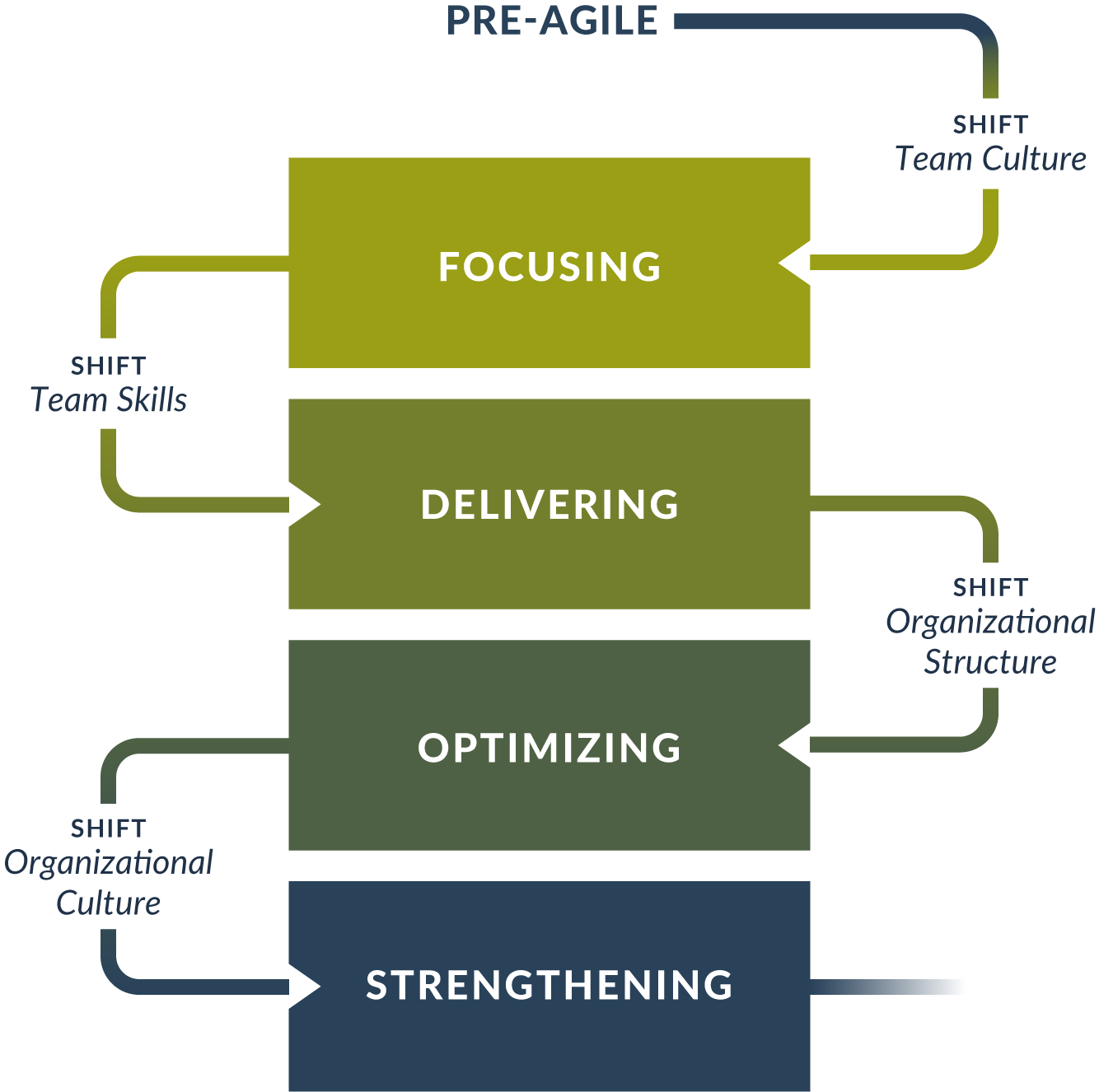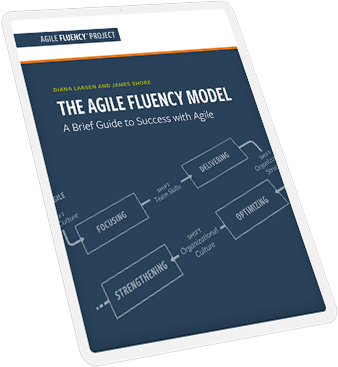The Agile Fluency® Model
How agile teams typically progress as they develop new capabilities
A successful team begins as a collection of individuals with complementary technical skills.
As the team adopts agile practices, a team culture shift occurs: instead of planning in terms of technical considerations, such as software layers or modules, the team now plans in terms of business, customer, or user benefit, exhibiting Focusing fluency.
Mastery of technical practices like test driven development requires greater investment and, usually, more time. Once a team skills shift occurs that eliminates technical limitations to delivering working software, the team exhibits Delivering fluency.
Where circumstances require, the team may internalize the capability to understand and address market needs. When an organizational structure shift moves key business capabilities inside the team, the team may exhibit Optimizing fluency.

Achieving Fluency
Skillful practice under pressure
Fluency is routine practice mastery that persists under stress. Anyone can follow a set of practices in a classroom setting. A team’s true fluency is revealed under pressure and in the face of distraction.
Deliberate, consistent practice
Whether learning to speak a language, play an instrument, or develop software in a new and better way, the pathway to fluency involves deliberate practice. Deliberate practice involves regularly and consistently practicing a skill with increasing levels of challenge and the intention of mastering that skill.
Organizational Fluency = Team Fluency
Agile development is fundamentally a team effort and the success of an organization ultimately depends on its teams. The Agile Fluency Model is a model of team fluency. Team fluency depends on more than the capabilities of the individuals on the team. It also depends on management structures, relationships, and organizational culture, as well as the tools, technologies, and practices the teams use.
Progress stalls without focus and support
Sadly, many agile teams have plateaued. While continuous improvement is a critical foundation for agile methods, these teams have stopped making progress and are no longer developing new capabilities to benefit themselves and their organizations.
Such teams lack the right direction, the right focus, or the right conditions for deliberate practice.
While there are many valid destinations on the pathway to Agile Fluency, and progress isn’t always needed, lack of progress is often due to misunderstandings about what capabilities the team needs, what benefits to expect from those capabilities, and the organizational investment necessary to progress.

The Agile Fluency Model eBook
A Brief Guide To Success With Agile
Diana Larsen and James Shore originally published the Agile Fluency Model in 2012. The model grew from their collective experience working with many agile teams. They refined the model through collaboration with skilled practitioners and with advice from other leading thinkers in the agile community.
German, Spanish, Chinese, French, and Catalan translations are available, courtesy of the Agile community.
For an even deeper dive, check out The Art of Agile Development
Understand where your organization needs to be
There is no right destination on the pathway through Agile Fluency. Investment at any point along the pathway can yield benefits.
Focusing
Some organizations are winning when they realize the collaboration, transparency, and cost savings that come from Focusing on business results.
Delivering
Other organizations require the minimal defects and high productivity that allows them to ship on cadence and receive the market boost that comes from consistently Delivering when the market demands.
Optimizing
Yet other organizations need to anticipate the market, dance with change and receive the benefits that come from smoothly Optimizing their value and applying their market expertise in new ways.
Your “Best-Fit” Agile
One-size Agile does not fit all! Once you use the Agile Fluency Model to understand where your organization needs to be, you are ready to start enjoying best-fit Agile.
Agile: essence and fluency
Martin Fowler was an early supporter of James Shore and Diana Larsen’s Agile Fluency Model. In this twenty minute talk, Fowler reviews the history and essence of agile software development and introduces the model.
Justify investment in the right capabilities
Fluency results from investment in learning. It also depends on management structures, relationships, organizational culture, and more. Although teams follow the Agile Fluency pathway, the organization underwrites the trip. Progress falters when leaders are unprepared to make required changes and sustain necessary capabilities. You can use the Agile Fluency Model to build a case for investments that will bring about the benefits your business demands.